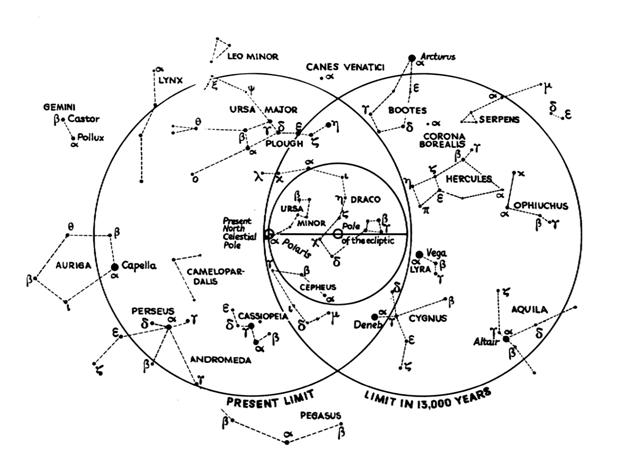1. If raaraa in Gb6-20 should indicate the whereabouts of winter solstice, then a natural question to ask is if a 'star pillar' could be located there, in the middle of the 'water':
6 days later comes Sirrah, which I have named 'The Woman in Chains' (perhaps the same 'person' as the old woman watching from the corner, the one who never slept and who never moved because she was stone from the waist down), and this star coincides with where 'land' (the Pegasus Square) is rising from the 'water', when Sun can be regarded as reborn (today defined by spring equinox and 26,000 / 4 = 6,500 years ago defined by the end of winter solstice - in both cases from an observation post north of the equator). I have used my beginner's astronomy book as a source for the right ascension numbers of the 'star pillars', where the lowest number is 00h 06m for Sirrah. There are more than 200 bright stars listed in my book and there are 4 with a right ascension greater than 23h but less than 00h 06m:
Remarkably - it must be mentioned - Sirrah is not alone at right ascension 00h 06m. The other star is Caph (β Cassiopejae). 60 * 24 = 1440 and the probability for 2 stars out of 200 to have the same right ascension is low. Though the ancients would have noticed, I think, and search for confirmation in Allen's Star Names: "With α Andromedae [Sirrah] and γ Pegasi [Kerb, see above], as the Three Guides, it [Caph] marks the equinoctial colure, itself exceedingly close to that great circle; and, being located on the same side of the pole as is Polaris, it always affords an approximate indication of the latter's position with respect to that point. This same location, 32º from the pole, and very near to the prime meridian, has rendered it useful for marking sidereal time. When above Polaris and nearest the zenith the astronomical day begins at 0 hours, 0 minutes, and 0 seconds; when due west the sidereal time is 6 hours; when south and nearest the horizon, 12 hours, and when east, 18 hours; this celestial clockhand then moving on the heavenly dial contrary to the motion of the hands of our terrestrial clocks, and at but one half the speed." Alrai ('the shepherd') is rising 365.25 - 359.4 + 1.5 = 7 days later than Sirrah, which corresponds to a position immediately before that of raaraa in Gb6-20, and Alrai is according to my interpretation of the G text therefore a Sun-day. Alrai is not far from the north pole, its declination is 77º 21', about 13º away from it. If winter solstice is associated with the celestial north pole, then Alrai is a possible candicate for a pole star. The precession moves not only the equinoxes but also the celestial poles, as seen against the pattern of stars which remains 'fixed' on the sky roof. This diagram from Hamlet's Mill explains it:
Alrai (γ Cephei) is just outside the circular path of the pole, and according to Wikipedia the north pole will be positioned close to Alrai around 4000 A.D. Earlier, around 2500 B.C., the pole star was Thuban (α Draconis). Why should the creator of the G text have chosen Alrai instead of Polaris to indicate winter solstice? We remember that Polaris was the 10th Tahitian star pillar:
If we count 27 glyphs ahead from Gb6-26 (where I guess Sirrah could be) we will arrive at glyph number 436 (= 472 - 36):
I have classified Gb7-25 as an example of vaha mea, the open mouth of which probably indicates the 'opening' of a season. It seems to be a rather short season, because after 41 days comes Ana-muri:
|
|||||||||||||||||||||||||||||||||||||||||||||||||||||||||||||||||||||||||||||||||||||||||||||||||||||||||||||||||||||||||||||||||||||||||||||||














